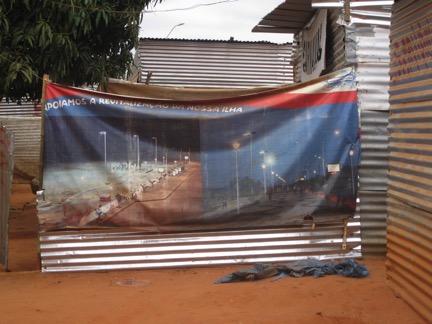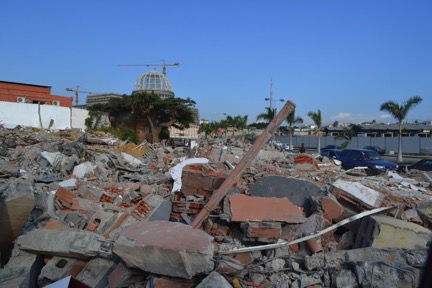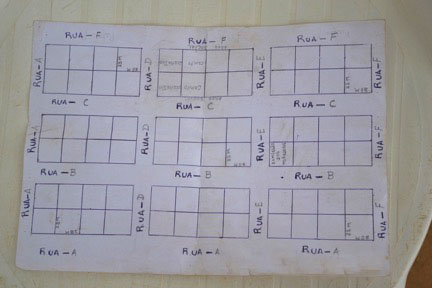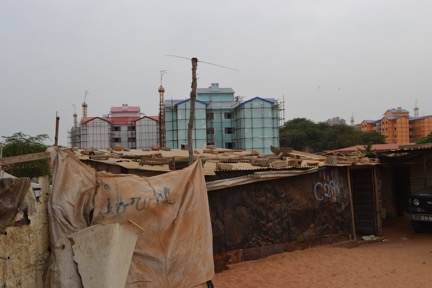In October 2011, I accompanied SOS Habitat, an Angolan housing rights organization, on a solidarity visit to a neighborhood in Luanda made up of people who had been forcibly removed from the city’s luxury leisure area, the Ilha.1 The Ilha is a spit of land that sticks out from the bay of this coastal capital. Surrounded by ocean on almost all sides, the wealthy flock there for lunches with ocean views and beach dance parties. The area, however, was also home to a large number of residents who lived in what Angolans would call the musseque or bairro, autoconstructed neighborhoods woven in between the sites of elite consumption.2
In 2009, the state had begun to forcibly remove these residents in order to allow private companies to redevelop the Ilha’s promenade and improve its leisure appeal. Possibly up to 3,000 people, who for decades had lived and worked on the Ilha, were moved to tent and corrugated iron settlements in an area named Zango, approximately 30 kilometers southeast of central Luanda. With little legal redress in the face of an authoritarian system, they waited in hope of one day being resettled in the matchbox houses that constitute the country’s post-conflict rehousing zones for the forcibly removed. In 2011, many were still waiting to be allocated homes, slowly reestablishing their lives after the links to their previous sources of livelihood, often fishing or informal trade in the city center, had been severed.3
As I made my way through the neighborhood, I was startled to come across a large banner advertising the redevelopment of the Ilha hung across the wall of one of the corrugated iron structures:

It portrayed sparkling images of a brightly lit nighttime promenade strangely devoid of people, with the words “We support the revitalization of our Ilha,” written across the top. The apparent possibility that someone who was violently removed from the Ilha supported the project that undergirded her removal seemed unlikely. And yet, in my experience, it is precisely the ambiguity captured in the question of whether the banner had been hung by a resident in criticism or praise of the project that lies at the heart of recent negotiations of the meaning of the slum in many African countries, especially in the face of the growing trend of satellite city construction aimed at severing new urban developments from the historical and social conditions of the existing city.4
As anthropologists such as Filipe de Boeck and Eric Harms have recently shown, aesthetic ideologies commonly associated with top-down urban planning have increasingly been taken up by the urban residents most likely to suffer as a result of such planning.5 These residents often describe the designs of high-rise buildings, gridlike streets, and gated communities—touted by the state and private companies as what should replace the “anarchic” musseques—as desirable and beautiful. If these certain idealized notions of urbanism are increasingly being internalized, what are the consequences for understanding the politics of the contemporary city, especially in African countries, where the idealized “city” has for so long justified the elimination of the majority architectural and social space—the slum?6
The term “the slum” has rightly been criticized for homogenizing a variety of diverse built forms and social circumstances, as well as stigmatizing those people who live in such areas as criminal and poor. However, it is arguably only by understanding local notions of the term—in the case of Luanda, the meanings and histories attached to the term musseque—that we can understand the ambiguity of how urban residents are grappling with new urban projects, and perhaps begin to understand what the grounds for imagining an urban future that speaks to the majority of the population, rather than trying to erase them, could be. Arguing that the language of the slum (in this case, the musseque) must be discarded misses the key point that “the slum” is constructed in relation to its imagined other, “the city.” To understand where our notions of “slum” emerge from, we will therefore need to interrogate our idea of the ideal city that co-produces it.
An ideal urban environment will always produce its imaginary other. It is therefore only by equally confronting the ideal city that we can begin to think seriously about the slum as both a space of its own production and something produced in relation to the city. In Luanda, the terms cidade (city) and musseque (slum) do not describe fixed points. Rather, they exist as a latent grammar through which urban areas, buildings, or persons can be identified in relation to a conversation, the objects and people around them, or in reference to another space. They are relational and ideological means through which the city is apprehended. They also come with loaded and contradictory connotations: The musseque is a site of disorder, precariousness, and danger, as well as the location of “authentic” urban culture and the national liberation struggle. Depending on the conversation, its inhabitants are both “the people” and criminals. The cidade can be an aspirational site of middle-class consumption, but also a concretization of elite corruption in its unapproachable real estate developments. It is precisely the dialogue between these material and ideological imaginaries—an understanding of the slum not just as a morphological form of the built environment but as a socially shared, concrete abstraction formed in relation to the city—that must be embraced in order to begin grappling with the politics of slumness and citiness in contemporary Africa.
Materialities of Occupation in Luanda
Angola is Africa’s second largest oil producer and experienced just over forty years of armed conflict, from 1961 until 2002, when what had begun as an anti-colonial war and morphed into a civil war finally ended. Since the end of the war, Luanda, the capital, has been the site of multiple slum demolitions. Buoyed by record oil profits, state institutions and private investors have carried out the forced removal of hundreds of thousands of people to make way for a hodgepodge of upscale real estate developments, infrastructural rehabilitation projects, and urban beautification programs. As a small elite gets rich off construction and speculation, a growing number of the urban population has been left homeless, landless, and angry.7


The antipathy of planners against slums is not unique to Luanda but has particular local discourses attached to it that are important in understanding what is at stake in slum demolition in the city. In popular narratives encouraged by the state, musseques are framed as the product of the war, blamed on the flood of internally displaced people into the city, and the incapacity of the wartime state to cope with this influx. This argument then portrays contemporary urban planning and forced removals as a reassertion of state presence in the city, done for the good of the population. At the same time, the musseques are also often described as “anarchic,” a nod to the assumed illegal status of their creation, and the assumed illegal practices of their inhabitants. But if we were to stop at these official representations, we would miss the meaning of the slum to those who inhabit it, the musseque as an imaginary within the space of the city, and with that, the imaginations of cityness that might flow from there. The musseque is not simply a space of marginalization, though it is that as well; it is a site of belonging and urban pride.8
A substantial body of research has indicated that autoconstruction is central to production of urban citizenship in the contemporary world. Autoconstructors, as James Holston has argued, are the “modern pioneers of city building.”9 As they expand the edges of the city through home construction, they claim rights to urban belonging. In Luanda, this is very much the case for the people who live in what some might call the slum. During the war, and into the present, the autoconstructed house became the prime index of financial stability and urban status. One belonged to the city if one had a house. Even if food was scarce and public services almost nonexistent, the musseque house provided a sense of substantive inclusion despite its owners’ location on the margins of the political and socio-economic order of the city.
It is this sense of belonging that is being challenged in the contemporary post-conflict moment, as the Angolan government’s public embrace of housing projects sourced from China, South Africa, and Brazil has led to autoconstructed houses being increasingly seen as a blight, as risky rather than stable in popular discourse. This is not to say that people were not disparaging of them before, or that people have not previously demanded better living conditions. A lack of basic social services is not something anyone celebrates. This contemporary shift in housing policy and discourse does seem significant, however, in the specificity of its material, economic, and aesthetic project, and its subsequent political consequences. Companies such as Brazil’s Odebrecht and the Hong Kong–based China International Fund have designed and built new mass housing that the government advertises as a positive alternative to existing musseques, despite the fact that the population expresses decidedly mixed feelings about these constructions. In demonizing the very materiality and aesthetics of the musseques, new urban projects emphasize how citizenship is tied to an aesthetic politics of concrete and surfaces. Official notions of belonging shift in relationship to the transformation of urban ideals, as some structures, and with that their inhabitants, are suddenly configured as undesirable and disorderly. Slum residents are aware of these changes and respond accordingly in verbal and material ways. The slum, therefore, becomes a site where urban residents negotiate the question of citizenship in relation to larger aesthetic abstractions and material politics. It is in tracking these negotiations that we can begin to understand the formation of local notions of political inclusion as expressed in urban materiality and space.
Aesthetic Belonging10
The importance of understanding the grounded social imaginaries of the slum as opposed to embracing a technical language to describe the musseque, was emphasized to me in my discussions with demolition victims in Luanda. Perhaps the most extreme version of urban residents’ sense of the relationship between imaginations of city, slum, aesthetics, and belonging emerged in discussions with the residents of an area I will call Bairro 2, as they tried to decide how to move forward after having waited eight years to be rehoused. In January 2012, following the Provincial Government’s failure to honor its promise to begin rehousing them in September 2011, a neighborhood meeting was called to discuss what should be done. They decided to begin building houses in cement block, a method that was, until recently, the most solid indication of urban permanence for the poor. Prior to this, Bairro 2 residents had avoided building in cement, retaining the corrugated iron houses they had built next to the areas from where they had been displaced in 2004, both because they hoped to be rehoused and because they feared that the powerful signal of permanence that building in cement indexed would provoke the wrath of authorities and lead to another demolition. Their desperateness at their condition, however, had now trumped their fears.
Citing the success of other musseque neighborhoods in the area that had constantly rebuilt in brick until the state eventually ceased threatening them with demolition, one resident explained that Bairro 2 had decided to follow their examples:
We, that is, “the people” [o povo], thought to do it in this manner of reconstructing and urbanizing the neighborhood so that we could pressure the government to give us a response. If the government doesn’t respond, then, God willing, we will build and remain here until the end.
Although they had not recently been threatened with demolition, the seeming government silence regarding their presence was viewed as a dangerous situation. It meant, explained Samuel, a residents’ committee member, that the ruling party, the MPLA, was convinced that it would win the election in the area, and was therefore waiting for the election to take place, before it would send a force to limpar tudo (eliminate everything).11 If the houses were made of corrugated iron at that time, he thought their demolition would not elicit the same public outrage as if they were made of brick. Building in cement block was therefore a confrontational means of testing whether developers had given up their ambitions to expand the project and remove the residents of Bairro 2 completely.
But even as residents explained how they were going to force a confrontation with the state through the materiality of cement block, expressing a right to permanence and pride in their bairro, they were simultaneously capitulating to the understandings of good urbanity promoted by many state institutions and private real estate developers. The residents were not simply going to rebuild, but they would do so in a manner that echoed state-promoted images of good urbanism, order, and standardization.
Jorge, also a member of the residents’ committee, showed me the neighborhood plan:

To say that it was remarkably gridlike would be an understatement. These demolition victims had tried to adopt the point of view of the state, carefully laying out a grid of streets, a soccer field, and spaces for a church, a marketplace, and an office for the residents’ committee.12 The neighborhood’s plan was a conscious response to the aesthetic sensibilities of their wealthy neighbors and the demands of the state for “organization.” They were planning to put walls around all of the houses because the government, as Jorge explained, “normally say that we build without logic, but with a wall, a house looks different.”
The next day, Samuel explained that they were building in a standardized way because they did not want their wealthy neighbors to think that there was a bairro desorganizado (messy neighborhood/slum) next door. This, he was hopeful, would mean that any possible problems (i.e., demolitions) would be avoided. He argued that their project was almost a form of autoconstrução dirigida (state-directed autoconstruction), because the layout of the neighborhood meant that access to roads and services would not be blocked. In this way, he said, they would be no different from what he referred to as the “luxury slum” (musseque de luxo) that bordered the other edge of Bairro 2. In that area, lots had been laid out by a public-private partnership in the 1990s and sold to the emerging middle class. Given that it lacked infrastructure, however, Samuel did not see it as qualitatively different from Bairro 2, hence its classification as a “luxury slum.” “They have done the same as we are doing here,” Samuel said. “We are building roads; therefore, in the future, the government can come and put in infrastructure.”
As residents spoke of their plans, it became clear that they were evoking an aesthetic notion of what premised legality and belonging, as well as recognizing a shift in the politics of citizenship in the city. Their cement block houses were no longer enough to belong: They also had to be sculpted to a certain aesthetic, a certain imagination of the urban that appeared legitimate, in order to make a claim on the city. The tussle between the imaginations of slum and city were having substantial effects on the form and appearance of the musseque, something that could only be understood if one engaged not only with the clear need to demand land and housing rights, but with the grounded histories of understanding the position of the musseque, the politics of materiality, and struggles over aesthetics that are inherent to a term such as “slum.” A bairro was being built to mark their permanence, their citizenship, but was being shaped by the emergent architectures and urban forms of Angola’s post-conflict building boom. These ordinary urban inhabitants understood the liberatory and oppressive connotations of both the cidade and the musseque very well, and built in conversation with them.

The case of Bairro 2 shows not only that the slum is both a space and an imaginary, rooted in histories of specific places, but also that it is constantly in conversation, and in struggle, with its idealized other—the planned wealthy city. As urban planning, at least in Africa, leans ever more toward the latter, it does us no good to shy away from the negative connotations of the slum in the hope that doing so will somehow point to a more equal urban future. Autoconstruction might produce the grounds for citizenship, but we will not understand the idioms through which these forms of belonging are expressed, the kinds of built environments that are considered inclusive, nor the political repercussions of building new cities, if we do not understand the slum in relation to larger urban imaginaries. To interrogate and critique the idea of the slum, what is really necessary is to investigate the ideal of the city. Technical languages of “peri-urban settlements” that avoid the negative connotations of the term “slum” and reify the city will not help scholars do this. It is only when we look carefully at the slum and city as one formation—in which political subjectivities are crafted in relation to histories, materials, aesthetics, and experiences that constantly negotiate the notion of slum as negation and slum as affirmation of belonging—that we will move closer to an architecture and urbanism that embraces the majority.
-
The research for this article was made possible by the generous support of the National Science Foundation Doctoral Dissertation Improvement Grant (Award Number 1023797); the Social Science Research Foundation International Dissertation Research Fellowship, with funds provided by the Andrew W. Mellon Foundation; the Wenner-Gren Foundation Doctoral Fieldwork Grant; the University of Chicago Human Rights Program Pozen Fellowship; the University of Chicago Centre for the Study of Race, Politics, and Culture; and the University of Chicago Research Travel Grant. Special thanks also goes to the Centro de Estudos e Investigação Cientifica (CEIC) at the Catholic University of Angola for the institutional support during my fieldwork. ↩
-
The term musseque is slowly becoming less common because of the negative connotations that many feel it carries, which is closer to the English word slum. The term bairro, which literally translated means “neighborhood,” is instead increasingly used to describe areas that in the past would have been called musseque, as many Luandans feel it is a more neutral term. ↩
-
Although Angola is technically a multi-party democracy, most analysts describe it as an authoritarian state. As a simple indicator, the same party, the MPLA (Popular Movement for the Liberation of Angola), has been in power since independence in 1975, and President José Eduardo dos Santos will have been in power for 36 years this year, making him the second-longest-serving president in the world. Dissent is harshly stifled, often leading to the harassment or imprisonment of government critics. ↩
-
James Holston, The Modernist City: An Anthropological Critique of Brasília (Chicago: The University of Chicago Press, 1989). ↩
-
See Filipe de Boeck, “Inhabiting Ocular Ground: Kinshasa’s Future in Light of Congo’s Spectral Urban Politics,” Cultural Anthropology, vol. 26, no. 2 (November 2011): 263–86, and Eric Harms, “Beauty as Control in the New Saigon: Eviction, New Urban Zones, and Atomized Dissent in a Southeast Asian City,” American Ethnologist, vol. 39, no. 4 (November 2012): 735–50. ↩
-
The projection of various idealized cities has been the grounds for the segregation of the majority living in African cities since the colonial period. While during colonization racial prejudices were mobilized to justify urban segregation and removals, in the post-colonial period the languages of welfare, law, and beautification have become increasingly common as reasons provided for removals. Over the last decade, specifically, as urban renewal projects across Africa have gained ground, forced removals and attendant, state-directed mass housing in countries such as Angola, Nigeria, and Kenya have become notable. In almost all these cases, existing urban structures are classified as risky or inappropriate for “proper urbanism,” usually defined against a vague global city aesthetic. ↩
-
For more information on Luanda’s forced removals, see Amnesty International, “Angola: Mass Forced Evictions in Luanda—A Call for a Human Rights–Based Housing Policy” (AI Index: 12/007/2003) and “Angola, Lives in Ruins: Forced Evictions Continue” (AI Index: AFR 12/001/2007). See also Human Rights Watch, “They Pushed Down the Houses,” vol. 19, no. 7 (A) (2007). ↩
-
Marissa Moorman makes this point in her discussion of the multiple meanings of the musseques in Luanda. See Marissa Moorman, Intonations: A Social History of Music and the Nation in Luanda, Angola, from 1945 until Recent Times (Bloomington: Indiana University Press, 2008). ↩
-
James Holston, “Autoconstruction in Working-Class Brazil,” Cultural Anthropology, vol. 6, no. 4 (November 1991): 449. ↩
-
Most of this section is drawn from my article “Vamos Construir!: Revendications Foncières et Géographie du Pouvoir à Luanda, Angola,” in Politique Africaine 132 (2013–14): 49–72. Many thanks to Politique Africaine for letting me make use of the material for the purposes of the present article. ↩
-
Residents’ committees are unofficial governance units made up of members of a neighborhood that communicate neighborhood interests to local government as well as receive instructions from local government regarding certain activities such as vaccination campaigns. In many neighborhoods they are central to everyday administrative workings. For a lengthier discussion, see Sylvia Croese, “Inside the Government, but Outside the Law: Residents’ Committees, Public Authority, and Twilight Governance in Post-Conflict Angola,” Journal of Southern African Studies, vol. 41, no. 2 (July 2015): 405–17. ↩
-
See James Scott, Seeing Like a State: How Certain Schemes to Improve the Human Condition Have Failed (New Haven: Yale University Press, 1998). ↩
Claudia Gastrow is a Postdoctoral Fellow in the Department of Social Anthropology at the University of the Witwatersrand. Her research focuses on questions of citizenship, the state, material culture, and aesthetics in African cities, with a special focus on Lusophone Africa, particularly Angola.

